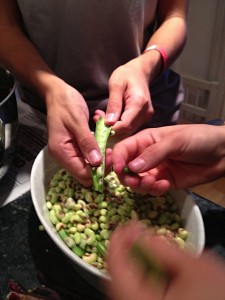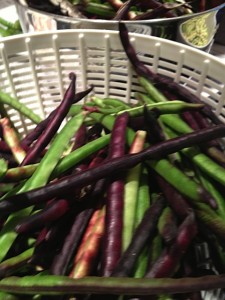I am pining for peas. Only two weeks on the calendar until the traditional pea planting day of March 17. But as I look out over the graying expanse of snow and ice that blocks the few modestly warm days from loosening winter’s grip on the hard-frozen ground, the feel of a pea seed sliding into dirt under gentle pressure from my thumb seems remote. Harder still to conjure that snap as the first snow pea of the season breaks free of the vine, still dewy wet in the early morning sun, and the sweet grassy juicy crunch of the first bite…
I ought to be planning my season of working in the garden and building raised beds but I need extra inspiration. What did it look like when snow did not blanket the beds? Let’s walk through some pictures from 2013.
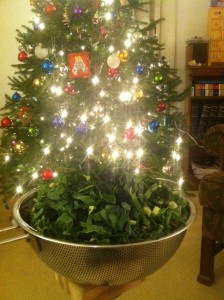 Just to remind myself of inevitable transitions, I’ll go back more than a full year, to January 1, 2013, when we harvested collard greens that were overwintering nicely – a bowl chiffonaded and ready to turn into our traditional New Year’s Day supper of black-eyed peas and collard greens.
Just to remind myself of inevitable transitions, I’ll go back more than a full year, to January 1, 2013, when we harvested collard greens that were overwintering nicely – a bowl chiffonaded and ready to turn into our traditional New Year’s Day supper of black-eyed peas and collard greens.
Collards seem to sweeten after a frost. Even without a protective cover, such as a cold frame, they seem to bounce right back and are ready for harvest any time the temperature exceeds freezing.
Collards keep on going past the winter into the new season, but don’t forget to plan new ones. Here are some tiny collards on their way in — I took this photo at the Whole Earth Center demonstration bed on March 30, 2013:
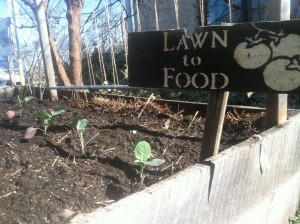 But what about the peas? The trellis is all set there in the back, but nothing’s coming up yet….
But what about the peas? The trellis is all set there in the back, but nothing’s coming up yet….
Let’s skip ahead another two weeks (oh what a long time that is when I’m waiting for seeds to sprout) to April 12, 2013, when — there they were! — the first pea sprouts of the season:
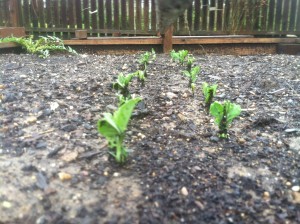
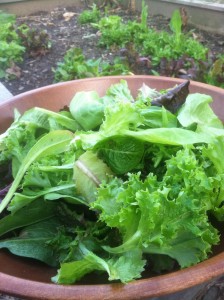 Ok, now we’re moving. Two days later, April 14, 2013, we had the first harvest of lettuce.
Ok, now we’re moving. Two days later, April 14, 2013, we had the first harvest of lettuce.
It’s hard to describe what happens when it’s time to pick lettuce: the sense of it being too early, really, for anything but a taste and the discovery that I’ve filled an entire salad bowl and hardly changed how the lettuce patch looks… the soft aroma of the leaves as I proudly carry the bowl inside… the profound realization of just how much more vibrant, precise and deep the flavors are compared to anything that can be bought in the store… the simple pleasure of welcoming a new season’s worth of flavor to the table.
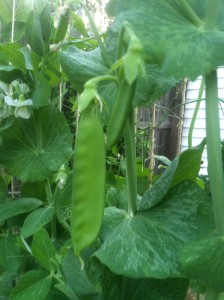 Meanwhile, back with the peas: Here’s one to harvest on May 30, 2013.
Meanwhile, back with the peas: Here’s one to harvest on May 30, 2013.
From that point on for the next several weeks they came like gangbusters. Snow peas and sugar snaps. Racing up the trellis, they formed a great green wall. Only this wall is specked by white flowers, each one signalling the arrival of a pea pod.
Don’t forget, the early shoots are delicious too. When we harvest lettuce, we often stop by the wall-of-peas and clip some tendrils to sprinkle on top of the salad bowl. Of course some chopped up peas go in the salad too.
Let’s change colors. Also on May 30, here’s what was coming from the raised bed four feet behind the peas. This is a case where red and green don’t signal Christmas whatsoever:
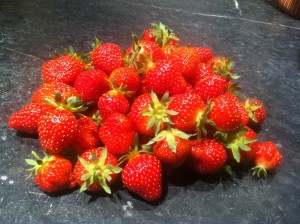 Again, the flavor of a strawberry from your own carefully tended soil can’t be bought.
Again, the flavor of a strawberry from your own carefully tended soil can’t be bought.
Oh, and did I mention the peas kept coming? June 4:
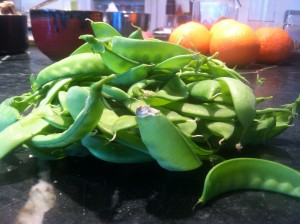
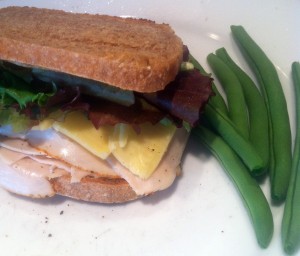 The green beans arrived by June 25 (joining the lettuce, which was still going strong).
The green beans arrived by June 25 (joining the lettuce, which was still going strong).
I like to come home for lunch and pick a few green beans to eat raw with a sandwich. They are sweet and crunchy like candy.
More colors – we had a bumper crop of pink-eyed purple-hulled peas. Fun to shell, delicious to eat. These photos from August 21 courtesy of Karla Cook:
But what about tomatoes? Apparently I was too busy eating them to take pictures. Ah, well they were still coming on strong into October. Here are a couple charmers on October 5. By October 12, the vines were looking a bit spent.
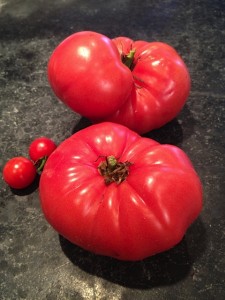
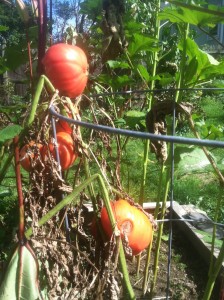 There’s no reason why the season should stop here. On this season’s ambitious list: Building an easy-to-use cold frame. Previous attempts have gone well enough to prove that lettuce can last pretty much all winter.
There’s no reason why the season should stop here. On this season’s ambitious list: Building an easy-to-use cold frame. Previous attempts have gone well enough to prove that lettuce can last pretty much all winter.
Well, what are you looking forward to this year? What were your triumphs from last year?


